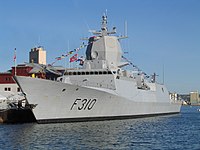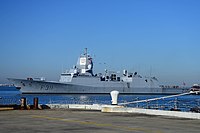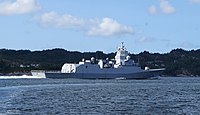Fridtjof Nansen class
|
|
|
|---|---|
 Frigate KNM Otto Sverdrup (F312) |
|
| history | |
| Ship class: | Fridtjof Nansen |
| Type ship: | KNM Fridtjof Nansen |
| Development shipyard: | Navantia , Ferrol , Spain |
| Keel laying: | 2003 to 2007 |
| Commissioning: | since 2006 |
| Data | |
| Displacement: | 5,290 t |
| Length: | 133.25 m |
| Width: | 16.8 m |
| Draft: | 4.6 m |
| Drive: | 2 shafts with adjustable propellers 2 Bazan Bravo 12V marine diesel engines , each 4.5 MW |
| Top speed: | > 27 knots |
| March: | > 18 knots |
| Driving distance: | 4500+ nm at 16 kn |
| Crew: |
120, accommodation for 146 |
| Armament: |
|
| Board helicopter | 1 × NHIndustries NH90 NFH |
| Combat system: | Aegis |
| Radar system: | AN / SPY-1 F. |
| Program costs: | $ 3 billion |
The Fridtjof Nansen class is a class of originally five frigates in the Norwegian Navy . After the Álvaro de Bazán class, it is the second class in Europe to be equipped with the Aegis combat system.
history
development
The history of the Nansen class began in the 1990s. At that time, the material fatigue of the Oslo-class frigates built between 1964 and 1966 gradually became noticeable. The accident and sinking of the Oslo in January 1994 were due to an engine failure caused by material fatigue. The Oslo-class frigates were Cold War-era structures designed to defend Norway against the Eastern Bloc , which collapsed in 1990. The planning of a class of more modern and internationally deployable frigates began.
Construction contract, technical problems and start of construction
In June 2000 the Spanish shipyard Navantia was awarded an order for five modern frigates, which are to be completed by 2009. A slightly “slimmed-down” version of the Spanish Álvaro de Bazán class was chosen as the design. Under this contract, Navantia would have built the first three frigates in Spain, while the last two units would have been completed with support from Spain and the delivery of large parts in the form of finished modules by Navantia in Norway.
There were massive technical problems, cost overruns and delays throughout the program. The last two units were built at Navantia in Spain, which should limit further delays and cost overruns. The construction phase of the ships was extended by a year.
In April 2003, the Fridtjof Nansen was laid down as the first unit . From then on, one ship was launched every year and the next one laid down on the same day. After the final equipment and extensive tests, the first unit was put into service on April 5, 2006 with a one-year delay. The other units followed on an annual basis between mid-2007 and early 2011.
commitment
The first combat mission of the Fridtjof Nansen , still without an on- board helicopter , was a participation in the EU operation Atalanta . For this purpose the frigate ran out of its home base in Haakonsvern near Bergen on August 1, 2009 .
technology

Stealth technology
The Nansen class, like most warships in the process of being procured or planned, is built according to stealth principles , i.e. in such a way that they are as difficult to locate as possible. The main focus of the developers is usually on the radar return and the infrared signature. The desire for the lowest possible radar reflection leads to the characteristic smooth and sloping outer walls, as is the case with the Nansen class. Rocket starters, guns, dinghies etc. are also disguised. The second point is to reduce the heat radiation, as this can be located by infrared sensors. The main problem here are the exhaust gases, which are therefore mixed with air in a complicated process and cooled before they are emitted. The advantage of these techniques is that the ships cannot be located by the enemy until relatively late. However, the total invisibility suggested by some media is not possible. Stealth ships like the Nansen class cannot be compared with stealth aircraft either . Ships are often on mission trips for months and are constantly exposed to aggressive seawater, which is why many special coatings used in military aircraft construction cannot be used on ships.
Aegis combat system
All units of the Nansen class are equipped with the Aegis combat system and the associated AN / SPY-1 F radar. Both components are from the American defense contractor Lockheed Martin manufactured and originally for Ticonderoga cruiser of the US Navy developed. Since the Nansen class is only half the size of Ticonderogas and is still almost 20 percent smaller than the previously smallest ships with Aegis, the Álvaro de Bazán class , a new radar had to be developed that was so large that it can also be used on smaller frigates. So the AN / SPY-1D became the AN / SPY-1F.
The task of the Aegis combat system is to network all sensors, computing systems and effectors on board the ship and, on the one hand, to be able to provide the commander with a comprehensive picture of the situation and, on the other hand, in the event of an attack, the time between the discovery of the attack and the creation of the fire control solution and finally to minimize the use of defense systems.
The SPY-1F is a three-dimensional phased array radar ; it is the main sensor of the Aegis system.
Sonar systems
The Nansen class is equipped with two different sonar systems for locating submarines : the MRS2000 built into the hull and the (actively and passively working) tow sonar of the CAPTAS Mk2 type. The Thales Group is the main contractor for both systems .
communication
An integrated communication system from the manufacturer Aeromaritime Systembau GmbH from Neufahrn b. Scaffolded Freising. UHF and SHF satellite communication as well as NATO's Link 11 data exchange system are all set up . For future upgrades, space has been left for the Link 16 that is already in operation and the Link 22 that is under development .
Accommodations
Although the Nansen class is about three times the size of the previous Oslo class, it has the same crew. Therefore it was possible to accommodate the crew much more comfortably. Taking into account the change in the range and area of operations from the North Sea and the North Atlantic for the Oslo class to worldwide peacekeeping operations for the Nansen class, this appeared necessary.
Armament
The widespread light gun 76/62 Compact from the Italian armaments company Oto Melara was chosen as the ship's gun . It can be used against land, sea and air targets. Later, however, the trend in many other navies went back towards guns with a larger caliber, as these have a greater range and penetration power , especially against land targets . For the Norwegian Navy it should also have been important that their new Skjold-class speedboats use the same gun, which can have logistical advantages.
The American Mk 41 Vertical Launching System is equipped with eight cells for air defense . Each of these cells holds a Quadpack ESSM . This means that each ship can carry up to 32 ESSMs. For the future, space was left to be able to equip additional VLS cells if necessary.
As anti-ship missiles , two quadruple starters are Naval Strike Missiles (NSM) available. This anti-ship missile is manufactured by the Norwegian state enterprise Kongsberg .
To combat submarines, all five units are equipped with Stingray light weight torpedoes from BAE Systems .
To prevent attacks like the one on the USS Cole in 2000, 12.7 mm machine guns are also included .
helicopter
As the first combat ship in the history of the Norwegian Navy, the ships have the ability to permanently embark and use a helicopter. For this purpose, the ships are equipped with a hangar and a landing pad aft. The hangar can accommodate helicopters of the 10-ton class, such as the NH90 , which is intended as an on-board helicopter by the Norwegian Navy. If necessary, helicopters of the 15-tonne class can land on the landing site. This includes, for example, the AgustaWestland EH101 , which is used by the NATO nations and the North Sea countries of the United Kingdom and Denmark .
units
The new ships, which are all based in Bergen , are named after five national heroes of Norway who have made a name for themselves through discoveries: Fridtjof Nansen , Roald Amundsen , Otto Sverdrup , Helge Ingstad and Thor Heyerdahl .
| Identifier | Surname | image | Keel laying | Launch | Commissioning | Whereabouts | comment |
|---|---|---|---|---|---|---|---|
| F310 | Fridtjof Nansen |  |
April 9, 2003 | June 3, 2004 | April 5, 2006 | active | |
| F311 | Roald Amundsen |  |
June 3, 2004 | May 25, 2005 | May 21, 2007 | active | |
| F312 | Otto Sverdrup |  |
May 25, 2005 | April 28, 2006 | April 30, 2008 | active | |
| F313 | Helge Ingstad |  |
April 28, 2006 | November 23, 2007 | September 29, 2009 | will be scrapped | Will be scrapped for economic reasons following an accident caused by a collision on November 8, 2018 at Øygarden . |
| F314 | Thor Heyerdahl |  |
November 23, 2007 | February 11, 2009 | February 18, 2011 | active | Located in Haakonsvern as a spare parts store for the other frigates. |
Similar classes of frigate
Similar classes of frigate are among others
- City class ( Royal Navy )
- De Zeven Provinciën Class ( Dutch Navy )
- Baden-Wuerttemberg class (frigate 125, German Navy )
- FREMM (mainly French Navy and Italian Navy )
- Iver Huitfeldt class ( Danish Navy )
Web links
- Official Royal Official homepage of the RNoN for the Nansen class
- Official homepage of the RNoN for the Nansen class (nor.)
- Overview of the material of the RNoN
- Lockheed Martin article on AN / SPY-1F (PDF)
- Naval-technology products (Engl.)
Individual evidence
- ^ Website of the Norwegian Armed Forces: Første seilas med F311 ( Memento of October 3, 2008 in the Internet Archive )
- ↑ Official website of the Norwegian Armed Forces: Tredje fregatt på norske hender ( Memento of the original from May 2, 2008 in the Internet Archive ) Info: The archive link has been inserted automatically and has not yet been checked. Please check the original and archive link according to the instructions and then remove this notice.
- ^ A b Felix Selzer: "Helge Ingstad" is scrapped after an accident. In: Hansa International Maritime Journal. June 25, 2019, accessed on June 27, 2019 (German).
- ↑ Derfor firer de ikke flagget på KNM «Helge Ingstad». www.vg.no, November 13, 2018, accessed on November 13, 2018 (Norwegian).
- ↑ Frigate berthed for its spare parts. In: NewsInEnglish.no. September 30, 2013, accessed December 29, 2014 .